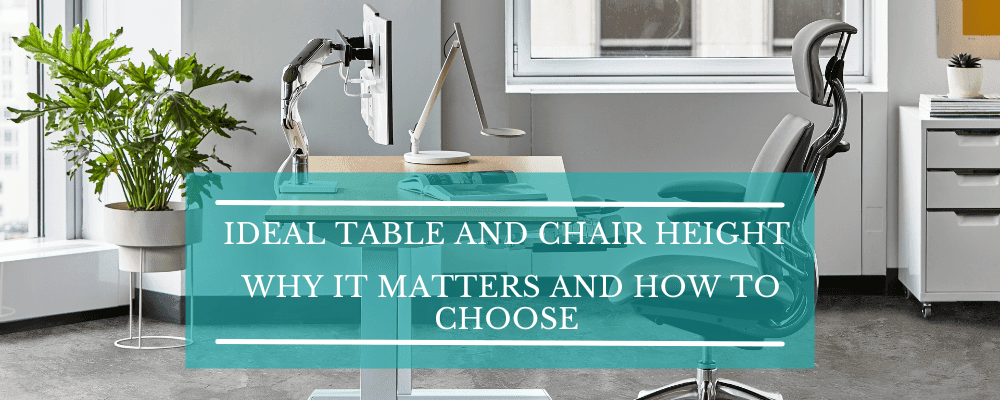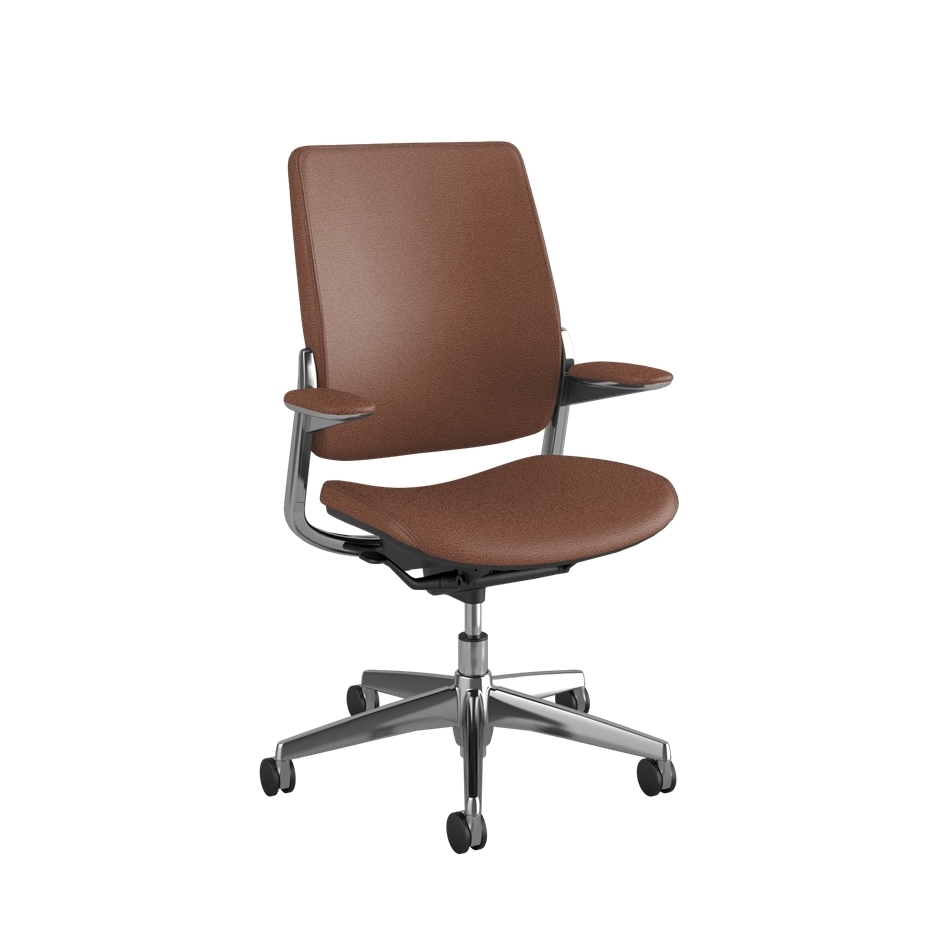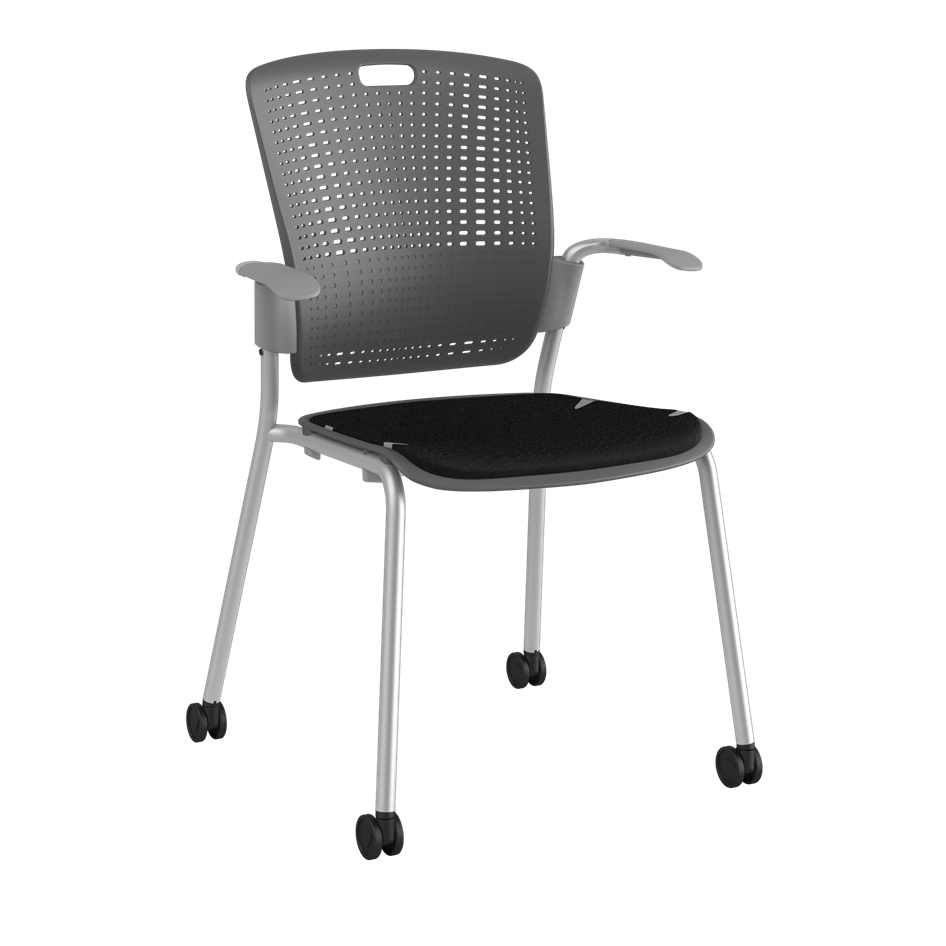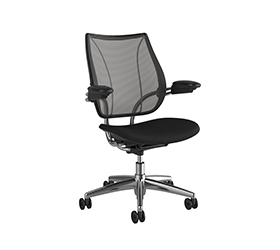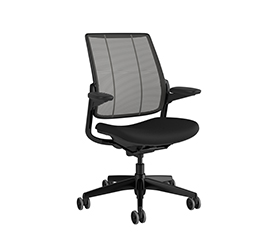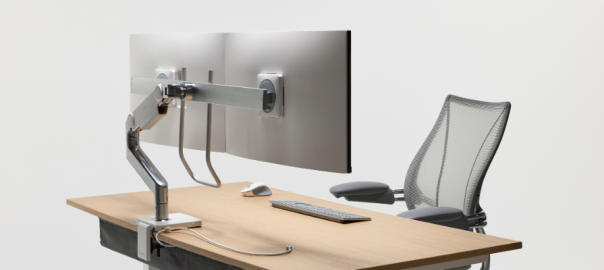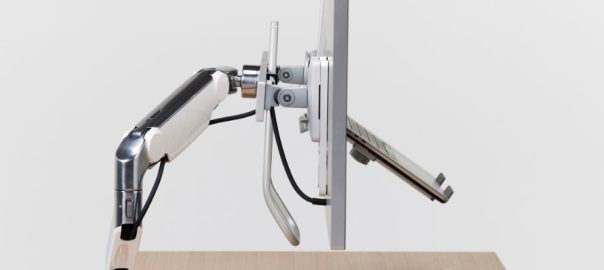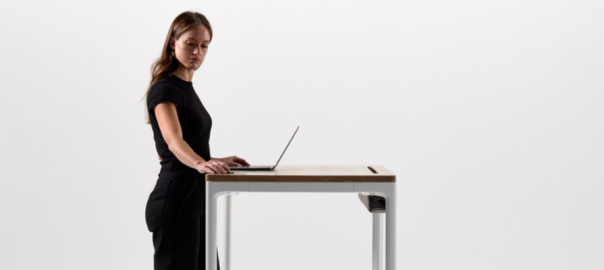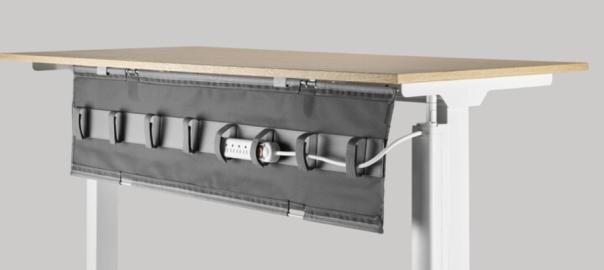Everyone today has created some kind of home office for themselves—that could be anything from an entire room to one corner of the dining room table. For most people, getting the work done is of utmost importance, with little regard for their own health. A 2023 study found that almost half of people get their desk and chair ergonomic measurements entirely incorrect; some are too high, while most are too low. 1 This not only leads to pain and discomfort but also decreases the person’s productivity.
It’s interesting to note that the standard office chair height isn’t a subject of concern for the individual alone. It could be advantageous for businesses to focus on the ideal desk height if they want to see their staff members return to the workplace. The benefits of ergonomic chairs include reducing absenteeism, with comfortable ergonomic task chairs playing a significant role.
But what is standard desk height? Important aspects to consider when looking for the ideal desk height are things like how your lower back is supported, the amount of pressure your knees feel, and so on. Let’s look at the details below.
The Importance of Desk Chair Height
Achieving the ideal balance between your table and chairs height can feel like an impossible task. If the standard office chair height is insufficient, then it forces your knees towards your chest, triggering painful discomfort. But if the desk chair height is too high, it strains your thighs and lower back. Striking the perfect balance ensures optimal spinal alignment and, consequently, sustained comfort during extended hours at your workstation.
Your desk and chair’s ergonomic measurements should complement each other. The standard office chair height falls between 40 and 53 cm, while the standard office desk height ranges from 68 to 76 cm. Maintaining these desk and chair ergonomics measurements prevents undue strain on your body.
Fortunately, ergonomic chairs are the ultimate solution to back pain. Unlike their conventional counterparts, ergonomic office chairs are designed to cradle your body, offering the kind of support an adult body needs. Its adjustable features are tailored to your unique physique.
So, why are office chairs so expensive? Ergonomic office products aren’t just furniture; they’re investments. For example, while a standard office chair might have a generic height, an ergonomic chair is designed based on extensive research to provide optimal support and comfort. The price tag reflects the extensive research, engineering, and premium materials that eventually come together in a product designed to elevate your workspace experience.
Risks of Incorrect Chair Height
While sitting for long hours is detrimental to your health, chairs with an incorrect height can set the stage for ergonomic hazards.
Poor Blood Flow Across The Body
Improper table and chair height disrupts healthy blood circulation in two ways. First, if your office chair is too high, your legs dangle, compressing blood vessels behind your knees. Second, a low office chair forces your knees sharply upwards, once again constricting veins in your thighs.
Both these scenarios translate to improper body posture, making it harder for the blood to return to your heart and thus impacting the nervous system.2 Additionally, blood pools in your legs, causing pain, fatigue, and numbness.
The Upper Body Takes A Huge Toll
Adjusting the chair height without following the standard desk and chair ergonomic measurements throws the entire body out of alignment. When your office chair is not positioned according to the ideal desk and chair height, your body has to move into an unsafe posture to work on the PC monitor. This continuously pressurizes the spine, causing disk degeneration and nerve constriction. This further results in severe pain in your back, shoulders, and neck.
Simply put, if the chair height is too high, you hunch to reach the desk, straining your neck and shoulders. Your back muscles overwork to keep you upright. Conversely, if the chair height is too low, you reach up with your arms, tensing your shoulders. Your spine curves unnaturally, putting stress on your back.3
Both positions strain muscles and ligaments, triggering pain and stiffness in your back, shoulders, and neck. This gradually leads to headaches and even posture deformities.4
Eye Strain
Eye strain happens when you stare for long periods at a monitor that does not correspond with your task chair height. Your eyes can feel pain and turn red, and you might experience severe headaches and blurred vision—otherwise called digital eye strain.5
If your office chair is too low, you’ll hunch over or tilt your head toward the computer screen. This forces your eyes to work harder to maintain focus on the text and images, straining the eye muscles. On the other hand, an office chair that’s too high makes you hunch down or crane your neck, leading to dryness, burning, and blurred vision.
Higher Risks of Musculoskeletal Disorders
Hunching for longer periods of time or stretching due to mismatched desk and chair ergonomic measurements can cause trouble, inevitably leading to work-related musculoskeletal disorders (WMSD) and chronic discomfort.
A poorly adjusted office chair forces you into uncomfortable, unsupported postures all day long. This improper posture can result in long-term injuries in several parts of your body, and eventually cause musculoskeletal disorders.6
When the ergonomic products are positioned correctly, your body is constantly in a healthy, supported posture that reduces the chances of these injuries or disorders occurring.
Benefits of Maintaining Proper Chair Height
Proper table and chair height isn’t just about comfort; it’s about taking care of your health and boosting your work productivity. Once your ergonomic office chair is adjusted to the correct height, you can begin to experience the true benefits of ergonomics in the workplace.
The benefits of maintaining proper chair height are as follows:
Reduced Risks of Work-Related Musculoskeletal Disorders (WSMDs)
Following the standard table and chair height guidelines can help you fight WSMDs by keeping your body in neutral alignment.
When your feet lie flat on the ground and your legs are bent by 90 degrees, your spine maintains its natural “S” curve. This significantly reduces strain on the muscles and ligaments supporting your back, preventing ergonomic hazards such as WSMDs. Additionally, inaccurate table and chair height compels your body to compensate by hunching or arching your back. This hampers muscle balance, resulting in tightness and potential tears. Maintaining the right chair height also ensures proper support for your arms, mitigating the risk of repetitive strain injuries (RSI) and wrist pain.
Further, with proper chair height, your weight distributes evenly across your buttocks and thighs. This reduces the pressure on your lower back and discs, which are prone to WMSDs.
Proper Blood Supply Across the Body
Keeping your feet flat on the floor and your knees at a right angle while sitting elevates your legs relative to your heart. Here, gravity plays its role by pulling back deoxygenated blood from your legs to your heart more efficiently.
Sitting with legs dangling or knees sharply bent can pinch blood vessels behind your knees, obstructing blood circulation. Implementing ideal height standards for ergonomic desks and chairs keeps your veins open and blood vessels unrestricted, enabling smooth blood supply.
Better Focus While Working
An ergonomic chair paired with the right table and chair height fosters concentration, enabling you to work more effectively without getting carried away.
Discomfort from a strained back, pinched nerves, or awkward leg positions due to incorrect chair height are constant distractions. A well-adjusted task chair reduces these issues, influencing you to dedicate your mental energy to the ongoing task.
When you’re uncomfortable, you move around to try to feel better. A properly adjusted office chair minimizes this need, keeping you engaged with your work for longer stretches.
Finding Ideal Table and Chair Height Adjustment: Key Elements to Consider
The following are the crucial ways to achieve the ideal table and chair height:
- Begin with Basics: Park yourself in your chair with your feet resting comfortably on the floor and knees at a comfy 90-degree angle. This basic sitting position sets the foundation for discovering your optimal comfort zone.
- Adjust Your Seat: Most office chairs come with handy levers or knobs for seat height adjustments. Start tweaking until your feet rest flat and your thighs are parallel to the floor. It’s all about good circulation and keeping that lower back happy.
- Armrest Alignment: Do you have armrests? Adjust them so they match your elbows when your arms are down. This keeps your upper body feeling supported and stress-free.
- Desk Check: Now, take a peek at your desk. It should line up with your elbows when they’re bent at a comfy 90-degree angle.7 Is the desk too high or low? That could spell trouble for your posture.
- Adjust Your Posture: Sit tall, with your back against the chair. Keep those shoulders relaxed and avoid slumping forward. This helps prevent back and neck strain.
- Fine-Tune Your Workspace: Give your new setup a whirl. Pay attention to any discomfort and make tiny tweaks as needed. Remember, it’s all about crafting a cozy and custom workspace.
- Keep an Eye Out: Throughout the day, check in with your body. A quick posture check can help you stay comfy and focused. Don’t hesitate to make minor adjustments as needed.
Important Tips on Determining Your Ideal Desk Chair Height
Here are some tips on setting up the height for your office desk chair:
- Familiarize yourself with the standard heights for office chairs and desks. These measurements provide a useful starting point for setting up your workspace.
- Optimizing your workspace for comfort and productivity starts with considering desk and chair ergonomic measurements like seat depth, armrest height, and lumbar support.
- Adjusting your desk and chair ergonomic measurements is crucial to achieving the ideal desk height. This means ensuring your elbows rest comfortably at a 90-degree angle when placed on the desk surface, promoting good posture throughout your workday.
- Pay attention to how you feel as you make adjustments to your chair height. If something feels off, make small tweaks until you find a comfortable position.
- Ensure your feet are flat on the floor or supported by a footrest to maintain good circulation and reduce lower back strain. Adjust your chair height accordingly for optimal comfort.
- If your ergonomic office chair has armrests, adjust them so they support your arms without causing strain. Properly positioned armrests can alleviate tension in your shoulders and back.
- After adjusting, sit in your chair for a few minutes to assess your comfort level. Make any necessary changes to ensure you feel supported and relaxed.
- Purchase an ergonomic office chair built to provide maximum comfort and support. While they may be more expensive, ergonomic chairs offer numerous benefits, including reduced work-related injuries and improved overall well-being.
Common Desk Chair Height Mistakes and How to Prevent Them
Here are some typical mistakes people commit while figuring out the ideal desk and chair ergonomic measurements:
- Focusing Only on Seat Height: While chair height is vital, you should consider the relationship between your task chair, desk, and arms. So, while adjusting the seat, ensure your forearms are parallel to the desk surface with your elbows bent at a 90-degree angle.
- Ignoring the Legs: You may adjust the chair height so that your feet touch the floor but later find your legs dangling or your knees slightly elevated. In that case, ensure that your feet rest flat on the ground and your knees are bent at a 90-degree angle while adjusting the seat height. If the office chair is too high, consider placing a footrest.
- Going With “One Size Fits All”: Most people purchase ergonomic chairs in a hurry without contemplating whether the furniture suits people with various physiques. Don’t make this mistake. Better look for these must-have features in high-quality ergonomic chairs such as lumbar support, adjustable seat height, and adjustable armrest height and depth.
Conclusion
We’ve gone beyond just understanding what is standard desk height and why it matters. We’ve also explored how to choose the perfect ergonomic furniture to perfectly suit your individual needs. As long hours of work increase, the need to take care of your health is growing in importance, and there is no better place to start than investing in the proper ergonomic products.
FAQ
1) How High Should A Desk Chair Be?
The ideal ergonomic chair height is when your feet are flat on the floor, and your knees are at a 90-degree angle. To determine the correct height, adjust the chair so that your thighs are parallel to the floor and your elbows form a 90-degree angle when resting on the desk. Typically, this means the seat height should be between 16 to 21 inches from the floor, depending on your height. This setup ensures proper posture, reduces strain, and promotes comfort during prolonged sitting.
2) What Is The Ergonomically Correct Height For A Desk?
For most people, the ideal desk height is approximately 28 to 30 inches (71 to 76 cm) off the ground. When typing, your elbows should be at a 90-degree angle or slightly open, and your forearms should be parallel to the floor, depending on your workstation height. Your feet should lie flat on the floor, and your wrists should be in a neutral posture. To maintain good posture, adjust the height of your chair and, if necessary, use a footrest if the desk is too high or low.
3) What Are The Signs That My Office Chair Is Too High?
If your office chair is excessively high, you may notice symptoms like: your feet do not rest flat on the floor, causing your legs to dangle, or pressure builds up on your thighs. This can cause soreness or numbness in your legs. Additionally, your knees may be positioned above your hips, resulting in an unnatural posture that affects your lower back. Your arms may also be tilted too high while typing, causing shoulder and neck discomfort. Adjusting your chair for optimum alignment can help reduce these problems.
4) Using A Footrest Help If Office Chair Is Too High?
Yes, a footrest can be useful if your office chair is too high. A footrest supports your feet and legs, keeping them in good alignment and preventing discomfort and strain. A footrest promotes a natural sitting posture by elevating your feet, decreasing pressure on your thighs and increasing circulation. This modification can make a high office chair more comfortable and ergonomic, encouraging better posture and lowering the chance of developing linked health problems such as lower back discomfort. It’s a simple yet efficient method for attaining optimum desk height alignment.

